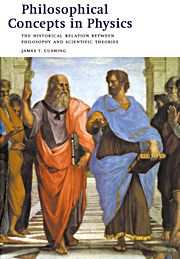 Philosophical Concepts in Physics
Philosophical Concepts in Physics Book contents
- Frontmatter
- Contents
- Preface
- Copyright acknowledgments
- PART I The scientific enterprise
- PART II Ancient and modern models of the universe
- PART III The Newtonian universe
- 7 Newton's Principia
- 8 Newton's law of universal gravitation
- 9 Some old questions revisited
- PART IV A perspective
- PART V Mechanical versus electrodynamical world views
- PART VI The theory of relativity
- PART VII The quantum world and the completeness of quantum mechanics
- PART VIII Some philosophical lessons from quantum mechanics
- PART IX A retrospective
- Notes
- General references
- Bibliography
- Author index
- Subject index
8 - Newton's law of universal gravitation
Published online by Cambridge University Press: 05 June 2012
- Frontmatter
- Contents
- Preface
- Copyright acknowledgments
- PART I The scientific enterprise
- PART II Ancient and modern models of the universe
- PART III The Newtonian universe
- 7 Newton's Principia
- 8 Newton's law of universal gravitation
- 9 Some old questions revisited
- PART IV A perspective
- PART V Mechanical versus electrodynamical world views
- PART VI The theory of relativity
- PART VII The quantum world and the completeness of quantum mechanics
- PART VIII Some philosophical lessons from quantum mechanics
- PART IX A retrospective
- Notes
- General references
- Bibliography
- Author index
- Subject index
Summary
A typical textbook summary of Newton's theory of gravitation presents his reasoning as a model in the application of scientific method. The scenario is roughly the following. Newton considered the rate at which the moon must ‘fall’ toward the earth in order to remain in its circular orbit and asked what centripetal acceleration was necessary to produce this motion. He concluded that the gravitational acceleration produced by the earth at the position of the moon decreased as the inverse square of the distance from the center of the earth compared to the known value of g at the surface of the earth. A bold generalization or induction from this yielded the law of universal gravitation between any two particles. Newton worried about the fact that the earth and moon were extended bodies, not point particles. By inventing the calculus he was able to prove that, as long as one was external to a uniform spherical mass, the sphere produced the same gravitational force as a point particle of equal mass situated at the center of the sphere. Then, using the law of gravitation plus his laws of motion, he deduced Kepler's three laws of planetary motion.
As we indicated in previous chapters and as we now show in more detail here and in the next chapter, the actual development, even as presented by Newton in his Principia, was a bit more circuitous and reflects his own philosophical view of the nature of science.
- Type
- Chapter
- Information
- Philosophical Concepts in PhysicsThe Historical Relation between Philosophy and Scientific Theories, pp. 103 - 113Publisher: Cambridge University PressPrint publication year: 1998


